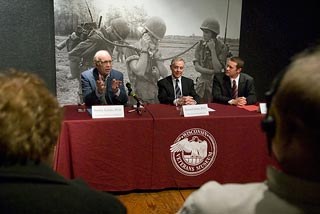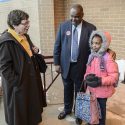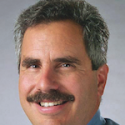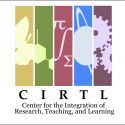‘Life During Wartime’ will build innovative curriculum around American war history
A new Wisconsin project funded by the U.S. Department of Education will feature an unprecedented partnership among public school teachers, university and technical college faculty, and the Wisconsin Veterans Museum to invigorate the teaching of American history.

Stanley Schultz, left, emeritus professor of history and a nationally known scholar on American history, comments on a new Wisconsin project, “Life During Wartime,” during a press briefing at the Wisconsin Veterans Museum on April 29, 2008. The $940,000 project, funded over three years by the U.S. Department of Education, is an unprecedented partnership among public school teachers, university and technical college faculty, and the Wisconsin Veterans Museum to invigorate the teaching of American history. Richard Zeitlin, center, is director of the Wisconsin Veterans Museum, and Todd Zoellick, right, is deputy U.S. secretary of education.
Photo: Jeff Miller
Called “Life During Wartime,” the $940,000 project will be funded over three years to connect eminent historians and veterans with 150 history teachers in the region. The project is intended to build a rich curriculum around the American experience at home and abroad, from the Civil War to the present, and build a political, social and personal connection to the nation’s past.
The partnership includes teachers from the Cooperative Education Service Area No. 5 (CESA 5) serving central Wisconsin and the Madison Metropolitan School District; historians from the University of Wisconsin–Madison and Madison Area Technical College (MATC); the Wisconsin Veterans Museum, an activity of the Wisconsin Department of Veterans Affairs; and veteran volunteers.
Jonathan Pollack, an American history professor at MATC, says “Life During Wartime” will have a particular emphasis on World War II and beyond, a segment of American history that is often under-presented in history teaching. The program will go beyond a political timeline, Pollack says, and go into the lives of soldiers deployed and their families at home during war.
He says that the program aims to add to the knowledge base of fifth grade through high school teachers with more detailed, specific material on American history topics. Susan Fulks, director of instructional technology service for CESA 5, adds that high school teachers in small-school districts such as those in the CESA 5 area often teach many social studies courses, which requires them to have a general knowledge of many areas.
“They teach three, four, five different classes, so they come in with a broad understanding, but they’re probably not history majors, so this will give them an opportunity to learn some content,” she says. She adds that many of them are the only social studies teachers in their school, and that bringing them together in the program as well as with Madison social studies teachers will allow them to build relationships and learn from each other.
Curriculum details are still being worked out before the project begins in July but will likely involve a weeklong summer institute as well as regular weekend programs and talks from renowned history scholars. Teachers will be paid for their time and receive one graduate school credit for the summer institute, says Jeremi Suri, a UW–Madison history professor, and substitute teachers will be provided for any school-year events.
“We’re trying to make it flexible and accessible for teachers, and we’re really trying to increase the contact and connection between the university, public institutions like the Veterans Museum, and teachers,” Suri says. “We really think this program allows us to enhance the Wisconsin Idea because we will be connecting even more deeply with people we should be connecting with around the state.”
The involvement of the Wisconsin Veterans Museum in this program will be a key aspect of that approach, Suri adds. The program will include a Web component that puts original historical resources online for teachers to incorporate into their lessons, a particular benefit for rural teachers without the centralized resources of a city like Madison. The Web site will remain online past the length of the grant and will be available to all teachers, even those not participating in the program.
Richard Zeitlin, director of the Wisconsin Veterans Museum, says the museum will provide the program with historical artifacts, manuscripts, photographs and, most importantly, the testimony of Wisconsin veterans from the past and present. The museum has an extensive collection of oral histories from soldiers, and veterans frequently volunteer at the museum to give tours and talk about their experiences.
“I look at involving veterans as a chance to underscore some of the points that are being made in the course of the program,” Zeitlin says. “We have people who actually were there, and we can have them available either on tape or in person or both, as well as hands-on learning.”
James Kurtz, a Vietnam War veteran who works with the Veterans Museum, says he appreciates the grant’s efforts to expand the knowledge of state teachers by offering a balanced look at war and wartime experiences.
“I came back to Madison after my Vietnam service, and it wasn’t a very pleasant place to be,” he says. “I really feel it’s important for the kids coming up and the people who are teaching them to understand both sides of the story.”
Beyond understanding the issue of war from all sides, Pollack adds that providing documents, artifacts and soldiers’ testimonies will ultimately allow students and teachers to better understand not just the facts of history, but the discipline itself and how history is studied.
“The students who come through history classes using this approach are going to be better equipped for college certainly, but even if they don’t go to college or they don’t go right away, they have a better understanding of how history actually operates,” Pollack says. “History is not a mysterious set of absolutes that’s beyond them — history instead becomes accessible and something that people in their daily lives can put to use.”
This remarkable partnership had humble beginnings at a 2007 Fourth of July picnic at a park in west Madison.
The holiday brought Pollack together with UW–Madison’s Bill Tishler, a media specialist in the Division of Continuing Studies. Each had recently been involved in applying for a federal Teaching American History grant with their respective institutions, but for various reasons, neither group received one that year.
As they continued to talk about the different challenges that each group faced, the two realized that they might have better luck earning the grant working together rather than apart.
“I was talking to him for like an hour. Our wives and our families were kind of circling around us, going ‘OK, come on, let’s go’, and we were like, ‘Wait a minute.’ It was all this shop talk on the Fourth of July,” Pollack says. The result was a grant proposal that built on the strengths of both institutions.
Subscribe to Wisconsin Ideas
Want more stories of the Wisconsin Idea in action? Sign-up for our monthly e-newsletter highlighting how Badgers are taking their education and research beyond the boundaries of the classroom to improve lives.



